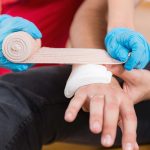What is facial droop?
Facial droop occurs when your facial muscles are not working properly. Your face may not look symmetrical, and you may have trouble moving your eyes and/or mouth.
Facial droop can affect one or both sides of your face.
What symptoms are related to facial droop?
The symptoms associated with facial droop depend on its cause.
Bell’s palsy symptoms usually appear quickly and gets better gradually. These symptoms may include:
- difficulty closing your eye or blinking on the affected side
- difficulty smiling or chewing food
- mild pain near your ear
- change in taste

Facial droop caused by a brain tumour normally develops slowly. A brain tumour can cause other symptoms including:
- headache
- loss of balance
- seizures
- loss of hearing or smell
- nausea
How is facial droop diagnosed?
If you have facial droop, your doctor will examine your face and look at how it moves. They will also do a full neurological examination to rule out stroke or other neurological causes.
Your doctor may order tests to diagnose the cause of your facial droop, including:
- CT scan
- MRI scan
How is facial droop treated?
Treatment options depend on what is causing your face to droop.
If your facial droop is caused by a stroke, brain tumour or illness, your treatment will address that condition.
Bell’s Palsy is usually treated with steroids to reduce inflammation.
Sometimes, facial droop can get better without treatment.
If your facial droop doesn’t go away, it is possible to have surgery to:
- close your eyelid
- correct a lopsided smile
If you also have uncontrolled muscle movements in your face, botox injections and physiotherapy can help.
Can facial droop be prevented?
Facial droop caused by conditions such as Bell’s palsy cannot be prevented.
However, you can reduce your risk of stroke by:
- eating healthily
- exercising regularly
- not smoking
- managing any conditions that increase your risk of stroke, such as:
- heart disease
- high blood pressure
- diabetes
- high cholesterol
- vascular disease
Complications of facial droop
People with facial droop can also experience problems with their:
- eyes
- hearing
- speech
- teeth
- eating and drinking
Talk to your doctor if you have any of these concerns, so they can refer you for support and counselling.
Eye complications
If you have facial droop, it is important to look after your eyes to prevent damage.
If your facial droop prevents you from shutting one eye, you will need to take steps to avoid complications.
- always wear sunglasses outdoors
- wear a patch to prevent things from getting in your eye
- use lubricating eye drops or ointments
- tape your eyelid shut when you go to sleep
In the case of a stroke, your facial droop will usually come on suddenly. Other muscles on one side of your body might also be affected. More stroke symptoms are:
- a severe headache
- a seizure
- blurred vision/changes in your vision
- being unable to lift one or both arms because they are weak and numb
- being unable to walk due to weak legs
- speech that is slurred or garbled
What causes facial droop?
Facial droop can be caused by conditions that:
- damage the nerves in your face
- damage to the part of your brain that sends nerve signals to your facial muscles
This damage can be temporary or permanent.
Bell’s palsy
If you are otherwise healthy, the most common cause of facial droop is Bell’s palsy. This occurs when the nerve in your face becomes inflamed. This is usually due to infection with a virus.
Bell’s palsy is usually temporary, but it could be up to a year before your face returns to normal.
Brain tumour
Facial droop can also be caused by a brain tumour. The tumour can press on your facial nerves.
Stroke
Stroke can also cause facial droop. A stroke occurs when blood is blocked from reaching the brain.
Other causes of facial droop
Sometimes babies are born with facial droop.
Other causes of facial droop can include:
- complications from surgery
- infection and inflammation, such as from Ramsay Hunt syndrome
- facial injury
When should I see a doctor?
Call triple zero (000) immediately and ask for an ambulance if you:
- suddenly experience facial droop
- experience symptoms of a stroke
Even if your symptoms quickly come and go, you should seek emergency care. Short lasting symptoms can be a sign of a transient ischaemic attack (a brief stroke-like attack). This can increase your risk of stroke.
If you experience facial droop that appears more gradually, see your doctor immediately, or go to your nearest emergency department.
How is facial droop diagnosed?
If you have facial droop, your doctor will examine your face and look at how it moves. They will also do a full neurological examination to rule out stroke or other neurological causes.
Your doctor may order tests to diagnose the cause of your facial droop, including:
- CT scan
- MRI scan
How is facial droop treated?
Treatment options depend on what is causing your face to droop.
If your facial droop is caused by a stroke, brain tumour or illness, your treatment will address that condition.
Bell’s Palsy is usually treated with steroids to reduce inflammation.
Sometimes, facial droop can get better without treatment.
If your facial droop doesn’t go away, it is possible to have surgery to:
- close your eyelid
- correct a lopsided smile
If you also have uncontrolled muscle movements in your face, botox injections and physiotherapy can help.
Can facial droop be prevented?
Facial droop caused by conditions such as Bell’s palsy cannot be prevented.
However, you can reduce your risk of stroke by:
- eating healthily
- exercising regularly
- not smoking
- managing any conditions that increase your risk of stroke, such as:
- heart disease
- high blood pressure
- diabetes
- high cholesterol
- vascular disease
Complications of facial droop
People with facial droop can also experience problems with their:
- eyes
- hearing
- speech
- teeth
- eating and drinking
Talk to your doctor if you have any of these concerns, so they can refer you for support and counselling.
Eye complications
If you have facial droop, it is important to look after your eyes to prevent damage.
If your facial droop prevents you from shutting one eye, you will need to take steps to avoid complications.
- always wear sunglasses outdoors
- wear a patch to prevent things from getting in your eye
- use lubricating eye drops or ointments
- tape your eyelid shut when you go to sleep



